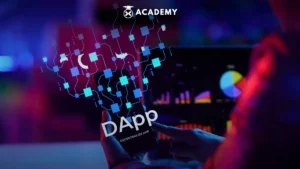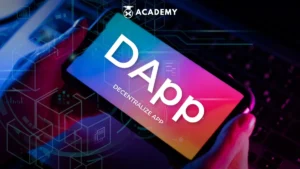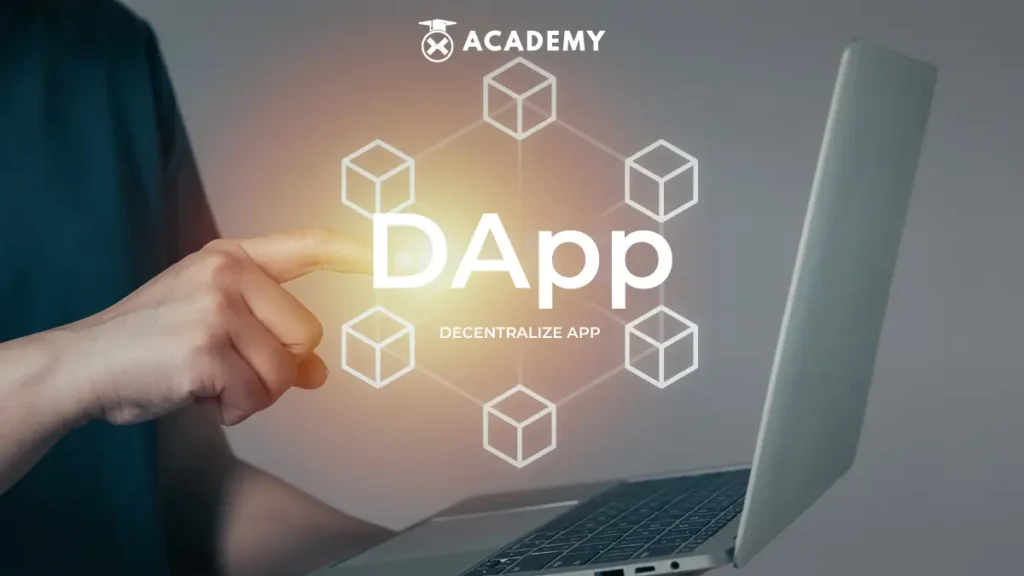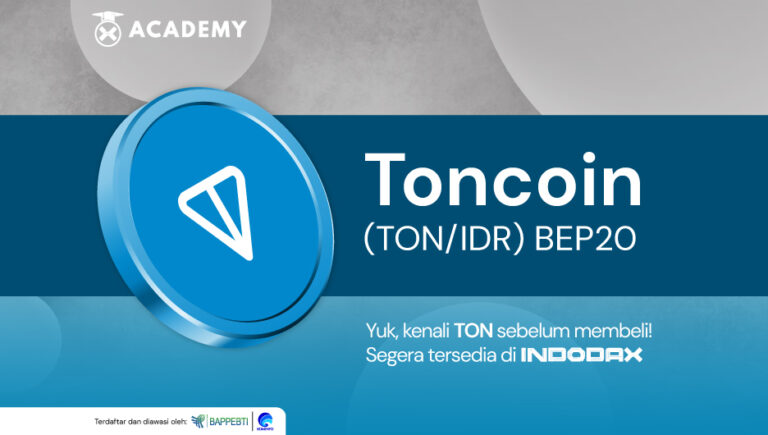In the crypto world, the entire transaction process occurs through various applications developed on a blockchain. These applications are known as dApp or Decentralized Application, which carries the principle of decentralization in its operations.
To understand more about the definition of Decentralized Application, its advantages, and main objectives, you can read this article to the end. By discussing the benefits and advantages of Decentralized Applications in-depth, we hope you can understand the crucial role dApps play in the blockchain ecosystem.
Decentralized Application is an important topic in the world of technology for several reasons. One of them is because dApps operate on blockchain technology, which allows transactions without involving third parties or central authorities. This results in a fairer and more transparent system, which can reduce the risk of manipulation and fraud. Apart from that, the Decentralized Application also uses cryptography and blockchain technology to secure data and transactions. Information stored on the blockchain is difficult to manipulate. Essentially, Decentralized Applications create the potential to change the way we interact with technology, data, and services as a whole.
What is a dApp?
The dApp or Decentralized Application is a type of application that operates on blockchain technology and uses smart contracts to carry out its operations.
It is known that Decentralized Applications differ from conventional applications because they do not depend on a single central server or single control authority. In contrast, a Decentralized Application uses a network of nodes distributed worldwide, making it decentralized and transparent. Decentralized Application users have full control over their assets and data as the network consensus makes decisions instead of a central entity making them.
Blockchain is the underlying technology that allows dApps to operate. Some of the roles of blockchain in running dApps include data storage. In this case, the blockchain stores dApp data decentralized across a network of nodes. This data is secure and difficult to manipulate.
Another role of blockchain in running Decentralized Applications is smart contracts. Smart contracts are programming code that runs on a blockchain that allows Decentralized Applications to carry out programmed functions without a central authority. On the other hand, blockchain uses consensus protocols to reach agreement on valid transactions. This ensures that dApp operations are carried out safely and fairly. Furthermore, blockchain cryptographic technology ensures the security of Decentralized Application data and transactions. Information stored on the blockchain is difficult for unauthorized parties to access.
Types of Decentralized Applications (dApp)

Knowing the types of Decentralized Applications will significantly influence the world of technology and digital finance. With a deep understanding of the types of Decentralized Applications, one will be able to become a smart user, wise investor, and active contributor in the ever-growing blockchain ecosystem. The following are the types of Decentralized Applications that you need to know, namely:
1. Money Management Applications
In this category, users can transact with other users via the blockchain network using their native crypto assets. Decentralized Applications usually have their own dedicated blockchain as a crypto asset, similar to Bitcoin.
2. Applications that Integrate Money
This type of Decentralized Application allows integration between digital money and real-world activities. For example, logistics companies can use RFID location chips to ensure cargo shipments reach their destination. Payment can be made automatically after delivery is complete, using existing funds on the blockchain. All of these processes run without human intervention after the buyer and seller sign the smart contract.
3. Decentralized Autonomous Organizations (DAOs)
DAOs are entities that are managed automatically based on concepts that have been programmed into the Decentralized Application. This concept includes who can become a member, how members vote on decisions, activities members can participate in, and how tokens, funds, or value are traded. All these operations occur according to the logic programmed within the Decentralized Application, creating an autonomous entity that runs without human intervention.
How Decentralized Applications (dApp) Work
It is important to know that Ethereum is a pioneer in the development of Decentralized Applications. In general, decentralized applications have backend code, known as smart contracts, that run using a decentralized network such as the Ethereum blockchain to store data and create application functionality.
The term “smart contract” refers to a contract that runs automatically when the terms and agreements between the buyer and seller are met. Developers write the code and develop these smart contracts. The smart contract code is open source, it can be used for other projects on the blockchain, including the creation of decentralized applications. The uniqueness of smart contracts is their ability to track transactions with high precision and prevent data changes.
Apart from smart contracts, Decentralized Applications also have a user interface (front-end) to facilitate user interaction. To run decentralized applications through a web browser, users need to install a browser extension to be able to interact with the blockchain and manage user identity. However, nowadays, Decentralized Applications are not only limited to the Ethereum blockchain. Many other blockchains such as EOS, Tron, and so on have also adopted the concept of Decentralized Application. This reflects the dynamic development in the blockchain ecosystem that is increasingly expanding across multiple platforms.
In developing a Decentralized Application, four important elements must be met: open source, decentralization, incentives (the application has digital assets in the form of crypto assets or tokens), and algorithms (using a consensus mechanism).
Decentralized Application that uses open-source software based on a decentralized blockchain system gives authority to many people as network managers. In other words, no single entity acts as a “leader” in this network. Instead, multiple parties can use and operate the network, giving Decentralized Applications freedom from external interference.
In a Decentralized Application, transaction nodes are shared among various validators. Users act as validators who validate the transaction process. This approach allows the transaction process to run more quickly and efficiently due to the active participation of the user community. Decentralized Application enables users to jointly make decisions, creating a decentralized and fair work environment.
Benefits of Decentralized Application (dApp)

It should be emphasized that by utilizing Decentralized Applications, users gain access to various services and actively participate in a more inclusive and fair ecosystem. It creates new opportunities, drives innovation, and changes the way people interact with the digital and financial world. Besides that, Decentralized Application provides a number of benefits and wonders that cover various aspects of the digital world. The following are a series of benefits from using Decentralized Applications in several contexts, namely:
GameFi
Decentralized Application brings a revolution in the gaming industry through the GameFi concept. The Decentralized Application allows players to earn real tokens and in-game assets that can be traded on the crypto market. This provides real incentives for players to actively participate in the game, creating a dynamic and profitable ecosystem.
Entertainment
Decentralized Application presents a variety of decentralized entertainment options, including streaming platforms, social media, and digital art markets. Through Decentralized Applications, users can access entertainment content, create it, or even earn income from the content they share. This provides unprecedented creative and economic freedom.
DeFi and DEX
One of the wonders of Decentralized Application lies in the decentralized financial revolution. Decentralized Applications in the DeFi field provide services such as loans, asset multiplication, and liquidity using smart contracts, without involving traditional financial institutions. Decentralized Application DeFi enables access to financial services for people who do not have access to conventional banking systems. Meanwhile, DEX facilitates trading of crypto assets without intermediaries, giving users direct control over their crypto assets.
Governance
In terms of governance and voting (governance), Decentralized Application creates a democratic mechanism for decision-making. Users can participate in the decision-making process through token voting, ensuring transparency and broader community participation in the management of blockchain projects and decentralized organizations.
Advantages and Disadvantages of Decentralized Applications (dApp)
It is also important to understand that knowing the advantages and disadvantages of dApps is very important in today’s world of technology and finance. With a deep understanding of the advantages and disadvantages of dApps, users can participate wisely in the blockchain ecosystem, support responsible innovation, and protect themselves from potential risks and financial losses. The following are various advantages and disadvantages of dApps that you need to know, namely:
Advantages of dApps
One of the main advantages of dApp lies in supporting user data privacy, where all data is stored encrypted on public networks, protecting user information from unauthorized access. This advantage becomes very relevant considering privacy violation cases in several conventional applications.
Additionally, because dApps are stored on public networks, the concept of freedom becomes more attainable. App owners do not have absolute power to remove or change content without user consent. This freedom provides space for users to interact and share without fear of arbitrary censorship or censorship. The use of public networks also reduces data storage costs, enabling more affordable access for everyone. This opens the door to higher innovation, with lower costs in application development and data storage.
Disadvantages of dApps
Despite their huge potential, dApps are still in the early stages of development. Therefore, they are still vulnerable to damage or operational bottlenecks. The innovation process takes quite a long time due to the technical challenges faced by developers. Apart from that, another drawback lies in the app’s complexity level. Decentralized applications generally require a deeper technical understanding, so users may experience difficulties when interacting with these platforms.
Additionally, adapting to the dApp concept requires time and effort from users, especially for those new to the world of decentralization. On the other hand, the limited code examples available to developers is another obstacle. Due to limited resources and implementation examples currently available, dApp developers still have to find their own way of building innovative applications.
Conclusion
In conclusion, in today’s digital era, Decentralized Application (dApp) plays an important role in changing the traditional paradigm of digital applications. The dApp offers users freedom, transparency, and active participation in a decentralized ecosystem. dApps enable users to interact, transact, and socialize securely and efficiently, without the need to involve intermediaries or central authorities. However, while dApps bring great benefits, they also face challenges, including technical complexity, complex usage, and security. Therefore, a good understanding of the benefits and challenges associated with dApps is essential in facing this ever-evolving digital era.
Learn about dApp on INDODAX Academy
So, now you understand what dApp is, the types, how it works, benefits, and advantages and disadvantages.
Furthermore, you can also read other interesting articles, such as understanding the basics of DEFI for beginners only on INDODAX Academy. As a reminder, INDODAX Academy is the best platform for learning the ins and outs of the world of blockchain and crypto assets in general. Later, after you understand the world of crypto assets, you can start investing in crypto on the official and trusted crypto asset buying and selling platform, namely INDODAX.
Well, what are you waiting for? Let’s increase our knowledge about the world of crypto only on INDODAX Academy!








